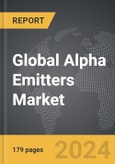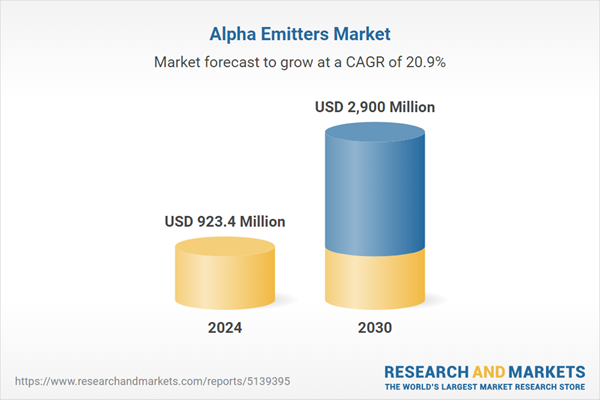The global market for Alpha Emitters was valued at US$923.4 Million in 2024 and is projected to reach US$2.9 Billion by 2030, growing at a CAGR of 20.9% from 2024 to 2030. This comprehensive report provides an in-depth analysis of market trends, drivers, and forecasts, helping you make informed business decisions. The report includes the most recent global tariff developments and how they impact the Alpha Emitters market.
Segments: Application (Bone Metastasis, Ovarian Cancer, Pancreatic Cancer, Melanoma, Other Applications).
Geographic Regions/Countries: World; United States; Canada; Japan; China; Europe (France; Germany; Italy; United Kingdom; and Rest of Europe); Asia-Pacific; Rest of World.
The analysts continuously track trade developments worldwide, drawing insights from leading global economists and over 200 industry and policy institutions, including think tanks, trade organizations, and national economic advisory bodies. This intelligence is integrated into forecasting models to provide timely, data-driven analysis of emerging risks and opportunities.
Global Alpha Emitters Market - Key Trends and Drivers Summarized
What Makes Alpha Emitters Pivotal in Cancer Treatment?
Alpha emitters have emerged as a critical component in the treatment of cancer, offering a unique and potent approach to targeting and destroying malignant cells. These radioactive isotopes, such as radium-223 and actinium-225, emit alpha particles that deliver highly localized and intense radiation. This characteristic enables them to effectively kill cancer cells while minimizing damage to surrounding healthy tissue. The precision and potency of alpha emitters make them particularly valuable in treating metastatic cancers and other hard-to-reach tumors. Unlike traditional radiation therapy, which can have widespread side effects, alpha emitters offer a more targeted treatment option, enhancing patient outcomes and quality of life.How Are Technological Advancements Enhancing Alpha Emitter Therapies?
Technological advancements have significantly enhanced the development and application of alpha emitter therapies. Innovations in radiopharmaceutical production and delivery systems have improved the stability and targeting accuracy of alpha emitters. Advances in molecular imaging and diagnostics have also played a crucial role, allowing for precise localization of tumors and better monitoring of treatment response. Moreover, the integration of alpha emitters with advanced drug delivery systems, such as nanoparticles and monoclonal antibodies, has further refined their targeting capabilities. These technological strides have not only increased the efficacy of alpha emitter therapies but also expanded their potential applications in treating a variety of cancers, including those that are resistant to conventional treatments.What Trends Are Shaping the Alpha Emitters Market?
Several key trends are shaping the alpha emitters market, reflecting broader shifts in oncology and personalized medicine. The growing emphasis on precision medicine has driven the adoption of alpha emitter therapies, as they align with the trend towards more individualized treatment approaches. Additionally, there is increasing investment in research and development to explore new alpha-emitting isotopes and novel therapeutic combinations. Regulatory support and the approval of alpha emitter therapies by health authorities have also boosted market growth, making these treatments more accessible to patients. Furthermore, the rising prevalence of cancer worldwide and the need for more effective treatment options have spurred demand for alpha emitters, highlighting their critical role in the future of cancer therapy.What Factors Are Driving the Growth of the Alpha Emitters Market?
The growth in the alpha emitters market is driven by several factors, primarily technological advancements, expanding applications, and evolving healthcare landscapes. Technological innovations in radiopharmaceuticals and precision medicine have significantly enhanced the development and deployment of alpha emitters, making them more effective and accessible. The expanding applications of alpha emitters in treating various types of cancer, including those resistant to traditional therapies, have opened new market opportunities. Additionally, the increasing prevalence of cancer and the growing demand for targeted and personalized treatments have fueled market growth. Strategic partnerships and collaborations between pharmaceutical companies and research institutions are accelerating the development of new alpha emitter therapies, further propelling market expansion. Moreover, regulatory support and the approval of alpha emitter therapies by health authorities have facilitated broader adoption, ensuring that these advanced treatments reach more patients. The combination of these factors ensures a robust growth trajectory for the alpha emitters market in the coming years.Report Scope
The report analyzes the Alpha Emitters market, presented in terms of units. The analysis covers the key segments and geographic regions outlined below.Segments: Application (Bone Metastasis, Ovarian Cancer, Pancreatic Cancer, Melanoma, Other Applications).
Geographic Regions/Countries: World; United States; Canada; Japan; China; Europe (France; Germany; Italy; United Kingdom; and Rest of Europe); Asia-Pacific; Rest of World.
Key Insights:
- Market Growth: Understand the significant growth trajectory of the Bone Metastasis Application segment, which is expected to reach US$993.8 Million by 2030 with a CAGR of a 20.4%. The Ovarian Cancer Application segment is also set to grow at 22.1% CAGR over the analysis period.
- Regional Analysis: Gain insights into the U.S. market, valued at $251.0 Million in 2024, and China, forecasted to grow at an impressive 19.4% CAGR to reach $426.9 Million by 2030. Discover growth trends in other key regions, including Japan, Canada, Germany, and the Asia-Pacific.
Why You Should Buy This Report:
- Detailed Market Analysis: Access a thorough analysis of the Global Alpha Emitters Market, covering all major geographic regions and market segments.
- Competitive Insights: Get an overview of the competitive landscape, including the market presence of major players across different geographies.
- Future Trends and Drivers: Understand the key trends and drivers shaping the future of the Global Alpha Emitters Market.
- Actionable Insights: Benefit from actionable insights that can help you identify new revenue opportunities and make strategic business decisions.
Key Questions Answered:
- How is the Global Alpha Emitters Market expected to evolve by 2030?
- What are the main drivers and restraints affecting the market?
- Which market segments will grow the most over the forecast period?
- How will market shares for different regions and segments change by 2030?
- Who are the leading players in the market, and what are their prospects?
Report Features:
- Comprehensive Market Data: Independent analysis of annual sales and market forecasts in US$ Million from 2024 to 2030.
- In-Depth Regional Analysis: Detailed insights into key markets, including the U.S., China, Japan, Canada, Europe, Asia-Pacific, Latin America, Middle East, and Africa.
- Company Profiles: Coverage of players such as Actinium Pharmaceuticals, Inc., Alpha Tau Medical, Bayer AG, Fusion Pharma, IBA Group and more.
- Complimentary Updates: Receive free report updates for one year to keep you informed of the latest market developments.
Some of the 12 companies featured in this Alpha Emitters market report include:
- Actinium Pharmaceuticals, Inc.
- Alpha Tau Medical
- Bayer AG
- Fusion Pharma
- IBA Group
- IBA Radiopharma Solutions
- Lantheus Medical Imaging, Inc.
- NTP Radiosotopes SOC Ltd.
- RadioMedix, Inc.
- Siemens Healthineers
- Telix Pharmaceuticals Ltd.
- Triad Isotopes, Inc.
Tariff Impact Analysis: Key Insights for 2025
Global tariff negotiations across 180+ countries are reshaping supply chains, costs, and competitiveness. This report reflects the latest developments as of April 2025 and incorporates forward-looking insights into the market outlook.The analysts continuously track trade developments worldwide, drawing insights from leading global economists and over 200 industry and policy institutions, including think tanks, trade organizations, and national economic advisory bodies. This intelligence is integrated into forecasting models to provide timely, data-driven analysis of emerging risks and opportunities.
What’s Included in This Edition:
- Tariff-adjusted market forecasts by region and segment
- Analysis of cost and supply chain implications by sourcing and trade exposure
- Strategic insights into geographic shifts
Buyers receive a free July 2025 update with:
- Finalized tariff impacts and new trade agreement effects
- Updated projections reflecting global sourcing and cost shifts
- Expanded country-specific coverage across the industry
Table of Contents
I. METHODOLOGYII. EXECUTIVE SUMMARY2. FOCUS ON SELECT PLAYERSIII. MARKET ANALYSISIV. COMPETITION
1. MARKET OVERVIEW
3. MARKET TRENDS & DRIVERS
4. GLOBAL MARKET PERSPECTIVE
UNITED STATES
CANADA
JAPAN
CHINA
EUROPE
FRANCE
GERMANY
ITALY
UNITED KINGDOM
REST OF EUROPE
ASIA-PACIFIC
REST OF WORLD
Companies Mentioned (Partial List)
A selection of companies mentioned in this report includes, but is not limited to:
- Actinium Pharmaceuticals, Inc.
- Alpha Tau Medical
- Bayer AG
- Fusion Pharma
- IBA Group
- IBA Radiopharma Solutions
- Lantheus Medical Imaging, Inc.
- NTP Radiosotopes SOC Ltd.
- RadioMedix, Inc.
- Siemens Healthineers
- Telix Pharmaceuticals Ltd.
- Triad Isotopes, Inc.
Table Information
| Report Attribute | Details |
|---|---|
| No. of Pages | 179 |
| Published | April 2025 |
| Forecast Period | 2024 - 2030 |
| Estimated Market Value ( USD | $ 923.4 Million |
| Forecasted Market Value ( USD | $ 2900 Million |
| Compound Annual Growth Rate | 20.9% |
| Regions Covered | Global |









